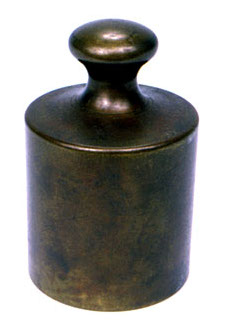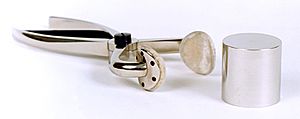Grave (unit) facts for kids

The grave (pronounced "grahv") was an early unit of mass. It was part of the very first metric system. This system was created in France in 1793. Just two years later, in 1795, the grave was given a new name: the kilogram.
Contents
The Grave's Beginning
The idea for the modern kilogram started during a time called the Age of Enlightenment. This was a period when people focused on reason and science. It also happened around the French Revolution. In 1790, a smart man named Talleyrand suggested a new system of measurements. He wanted a unit of length based on something natural. He also wanted a unit of mass (which they called "weight" back then). This mass unit would be based on the mass of a certain amount of water.
In 1791, a group of scientists in France worked on these ideas. They decided the unit of length would be one ten-millionth of the distance from the North Pole to the Equator. They called this new unit the metre.
Defining the Grave
In 1793, the scientists defined the unit of mass. They said it was the mass of a cube of distilled water. This cube measured one decimetre (about 10 centimetres) on each side. The water had to be at 0°C (the temperature of melting ice). They named this unit the grave.
They also created smaller and larger units based on the grave. For example, a "gravet" was 0.001 grave. A "bar" was 1000 grave. This helped them measure different amounts.
Since water is hard to use for everyday measurements, they made a metal copy. This metal object was a "practical" grave standard. It was easier to use for trade and other purposes.
From Grave to Kilogram
On April 7, 1795, a new law was passed in France. This law officially introduced the gram. The gram was defined as the mass of a cube of pure water. This cube measured one hundredth of a metre (one centimetre) on each side. The water was still at the temperature of melting ice.
New Names and Prefixes
The new law also changed the names of the units. Instead of gravet, grave, and bar, they used the single name "gram." The new gram was equal to the old gravet. They also added new prefixes to the metric system. These included "deca," "hecto," "kilo," and "myria." This created units like the milligram, centigram, and kilogram. The brass prototype of the grave was then renamed the "provisional kilogram."
Making it More Accurate
In 1799, scientists made the measurements even more precise. Two scientists, Delambre and Méchain, finished a new measurement of the Earth's meridian. This made the final metre slightly smaller. Because of this, the final kilogram (which was still based on water) became a tiny bit lighter.
They also changed the water temperature for the definition. Instead of 0°C, they chose 4°C. This is the temperature where water is at its densest. This small change made the final kilogram slightly heavier again. Scientists like Louis Lefèvre-Gineau and Giovanni Fabbroni worked on these precise measurements.
The Kilogramme des Archives
After all the definitions were finalized in 1799, a special kilogram prototype was made. It was crafted from pure platinum. The goal was for this metal object to have the exact same mass as one cubic decimetre of water at 4°C. This was as accurate as they could make it at the time.
This important prototype was called the Kilogramme des Archives. It was stored safely in the National Archives in Paris. On December 10, 1799, this platinum prototype officially became the standard for the kilogram. This standard was used for the next 90 years. Later, in 1889, it was replaced by the International Prototype of the Kilogram (IPK), which was even more precise.
See also
 In Spanish: Grave (unidad) para niños
In Spanish: Grave (unidad) para niños
- Gram
- International System of Units (SI)
- Kilogram
- Kilogram-force
- List of unusual units of measurement
- Mass
- Metric prefix
- Metric system
- SI base units
- SI derived units


